It’s no secret by now that I’m a fan of what Primary Arms has been releasing in their product line lately. Their combination of quality Low-Power Variable Optics (LPVOs) and longer-range optics at a competitive price makes this company easy to enjoy. There was a lot of excitement on my end when I heard of their new development when I heard about their “Auto Live Illumination Cap”, and I knew I had to get one in for a review on a Primary Arms Optic. If you’re the type of person to leave their illumination on accidentally and wear out batteries, this is an article you’ll want to stay for.
Check Price at:
Overview
The Primary Arms SLx series is no stranger to American Gun Facts. However, it’s important to note that the 1-10×28 series stands on its own legs compared to the others in its product line. Not only does it sport a 34mm tube (compared to its 30mm counterparts), but it also features the highest magnification range out of the Low-Powered Variable Optic (LPVO) SLx family that is provided by Primary Arms. The performance of this optic lived up to the standard I’ve come to expect from this scope series, as it took the concrete drop like a champ and tracked exactly how it needed it to.
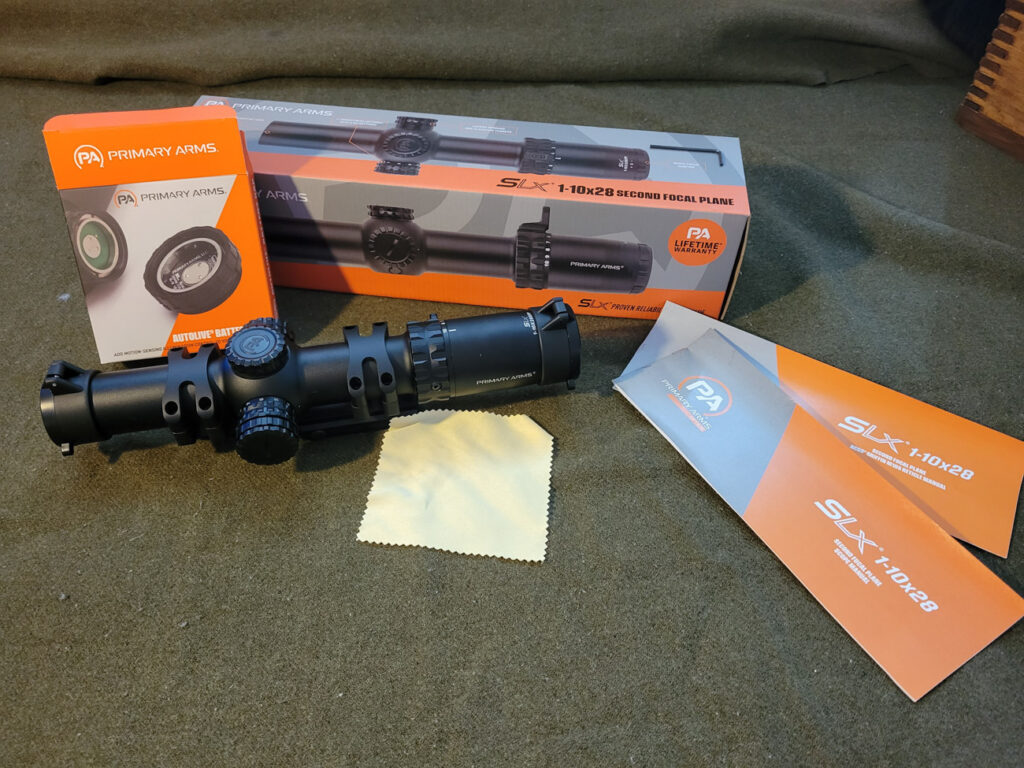
While I was nervous about the lack of a parallax knob, this LPVO ended up testing phenomenally and the parallax didn’t end up being an issue. Also being tested today is the Primary Arms Auto Live Battery Cap which is a motion-sensing illumination on/off switch that can save your battery life. This is a new product that was released in October 2023, and I’m excited to see how it can help in the long-term operation of the SLx. I won’t give too much away, so let’s get into the first impressions of the Primary Arms SLx 1-10×28 and the Auto Live Battery Cap.
First Impressions
Having been familiar with the SLx line before this review, the 1-10×28 was no exception to the quality out of the box that’s been a common theme with Primary Arms (PA). Flip-up lens caps came installed on the optic out of the box, and everything was crisp and ready to be installed. I decided to place this scope on my AR-15 in 223 which is a very common application for an LPVO. The Auto Live Battery Cap was also really simple and easy to install, though I never did figure out how to use the “wrench” that came in the box with it.

This is a scope that experienced LPVO users can appreciate. The adjustment turrets are low profile while the tube is nice and sizable, making this a pleasant scope to look through and use. The SLx are somewhat similar to each other, so this optic does share some similarities in design to the other SLx 1-6 that I reviewed in the past. However, with a 34mm tube and the different reticle design, I knew I was in for a different package than the last SLx LPVO.
Once the Auto Live Cap was installed, I tested its function throughout a couple of weeks, testing the timer and battery life. It was interesting to see the 2-minute timer and test the sensitivity of the cap. We’ll give the Auto Live Cap its section later in the article, so I shouldn’t say too much about its performance just yet. Let’s see what features the SLx 1-10×28 comes with.
Features
It’s worth mentioning that this optic has two night-vision compatible illumination settings on the illumination dial. While this feature may not be used by many enthusiasts, it’s awesome to see companies throwing in these types of features on value-priced options. Here are some of the other features included in the optic being tested today.
- 34mm Main Tube
- Illuminated Reticle
- 1-10 Magnification Range
- Primary Arms Auto Live Illumination Cap
- ACSS Griffin M10S Reticle System
- Night Vision Compatible
- 1/2 MOA Adjustments
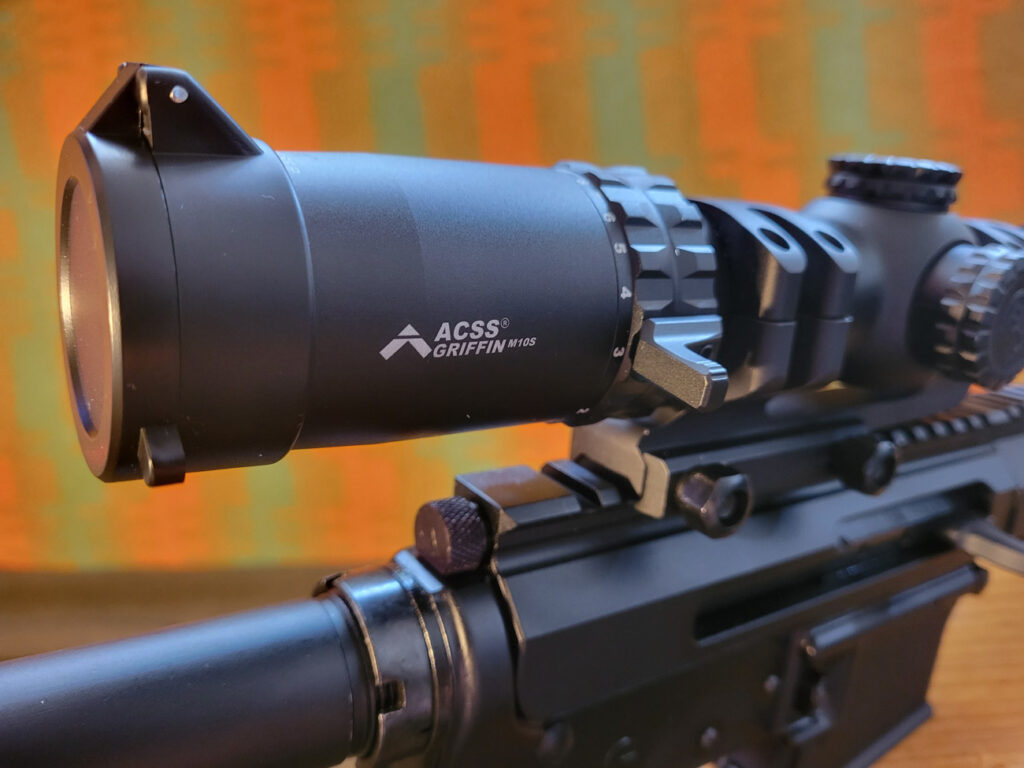
The ACSS Griffin M10S Reticle System is part of Primary Arms’ ACSS line and features a stacked data set that allows the user to keep a hands-off attitude when it comes to shooting at different ranges. This is a capped turret LPVO because it’s not meant to be adjusted past the zero of the rifle. Most of your distance-based adjustments can be accommodated for using the reticle system, and that’s one of my favorite things about Primary Arms. There will be a whole section on this reticle because it’s a big part of why this LPVO works so well.
The Auto Live Battery Cap is the second part of the review. This is a brand-new product by Primary Arms and it’s even compatible with scopes from Sig Sauer and Vortex Optics. The Auto Live Cap is a motion-sensed illumination switch that will automatically shut off your illumination if left alone for 2 minutes. So if you’re like me and you accidentally leave your illumination on in your optic for 4 months, you can install the Auto Live Cap and have it shut the illumination off for you. This will also have its section in the review since it’s a separate product from the SLx, but also a cool attachment to put in the cart.
Tracking & Accuracy
This optic produced one of the best tracking box tests since I’ve started reviewing optics. The spread between shots from box to box was 1.25 MOA at 100 yards, which is impressive seeing how the optic is only 10x with no parallax knob. Tracking accuracy is the most important thing to have confidence in when you’re finding the right optic for your firearm.
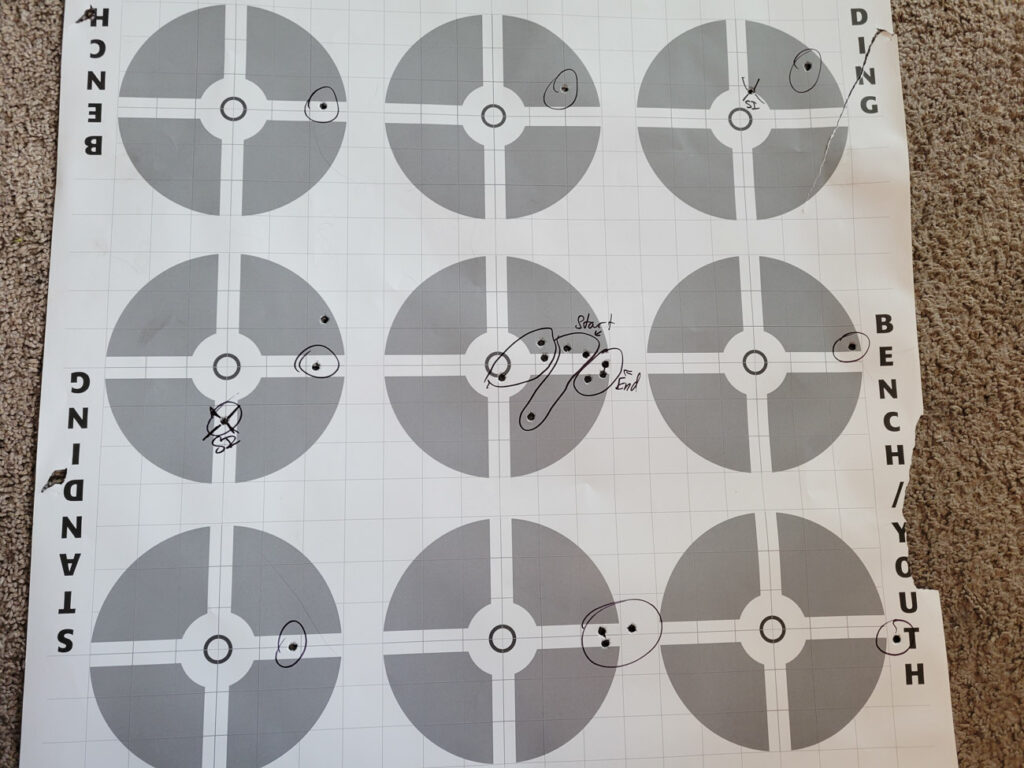
While these test results were extremely satisfying, I will mention that your fundamentals need to be sharp as a tack before using an LPVO like the SLx 1-10. Because there’s no parallax, your reticle, and target could be misaligned if you have inconsistent cheek weld or head position behind the gun. A shooter who isn’t consistent in their fundamentals could see a shift in their point of impact (POI) when shooting at extended ranges due to poor fundamentals.
Regardless of any strings that may come with the results, I was still able to put good groups on paper at 100 yards. Many 3-gunners would use this to engage targets at a farther distance, and while I would have the confidence to use the SLx for that purpose, I would make sure to practice with this optic as much as I could to get as comfortable as possible. Oh no, another excuse to go shooting more frequently! Now that we have all that out of the way with a passing accuracy test, let’s see how the durability test went.
Durability
All my tested scopes get dropped onto solid concrete from head height. The SLx 1-10, when dropped, passed the test flawlessly. It was difficult to see where on the scope it even landed. These optics get dropped on the elevation turret, and the only scuff marks I could find were on the Auto Live Cap (which still worked great) and on the flip-up lens cap that faces the shooter.

The coatings that go on the outside of these scopes must vary in quality as you jump from brand to brand. I’ve seen multiple manufacturers that have scope bodies that are easily scratched and dented. The common theme I’ve found with the coating used by Primary Arms is that it’s quite durable. Even the scuffs from the drop were wiped away and still retained most of the color so that it would blend with the scope body.
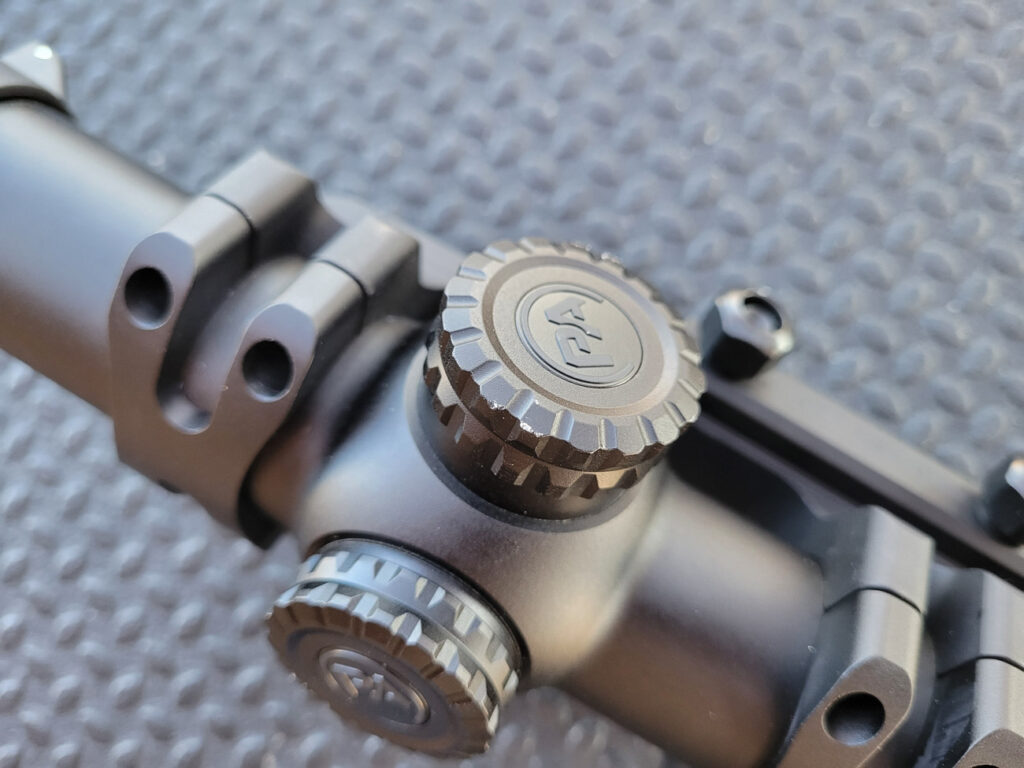
I should also point out that the POI shift was very minimal after the drop and was well within acceptable margins when taking optics off the gun and putting them back on again. I dropped the scope before doing the box test for tracking, so seeing how well it performed in tracking and accuracy, I’d say that the SLx 1-10×28 passed all my tests with flying colors. Not only is it accurate, but you almost couldn’t even tell it was dropped onto concrete, and that’s not something you can say with every optic out there.
Primary Arms Auto Live Illumination Cap
The way I see it, the Auto Live Illumination Cap is a clever solution to a problem some people don’t even know they have. I want to make something very clear, however, and it’s the fact that this is a storage solution and not an application solution. This means that the Auto Live Battery Cap would help if installed on an optic that spends most of the time idle or sitting in one spot. I don’t think it would be used frequently for someone who goes to shoot their AR in the middle of the day every weekend.
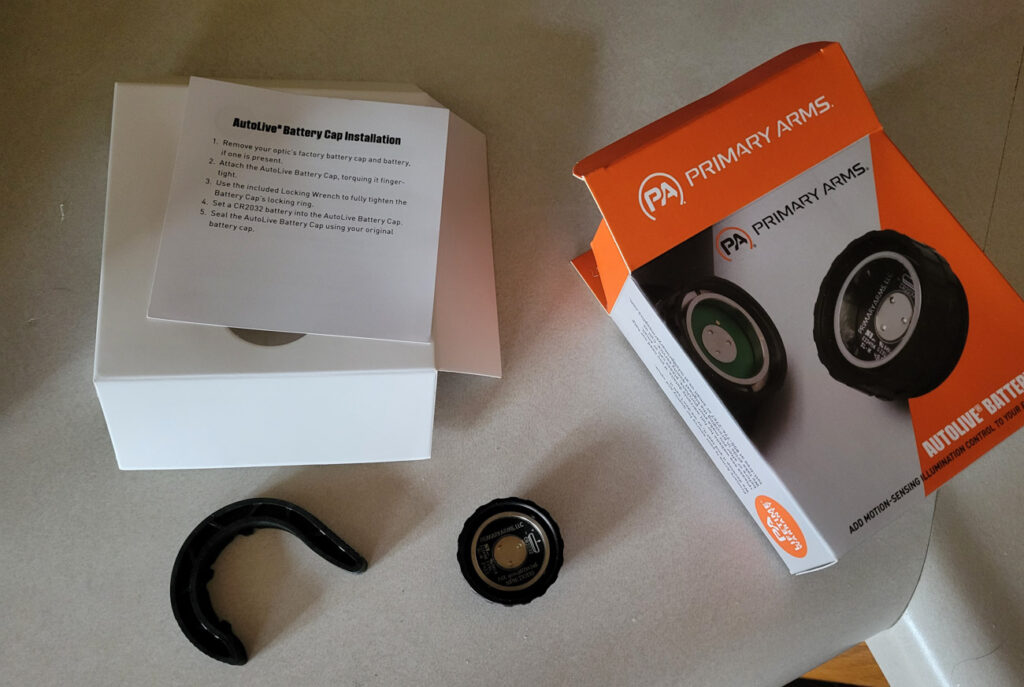
The movement sensors on the cap are sensitive. While testing the sensitivity, I bumped the buttstock while the rifle was installed in a wall mount, and the illumination turned on from a simple brush of the stock. If you want to leave your illumination on all the time, but transport your gun in your car a lot, it would be safe to say that major bumps from potholes and gravel would turn the illumination on if you left the dial on. That being said, for $50 I don’t see why you wouldn’t add this on to your optics purchase. Not only does it work on LPVOs that aren’t Primary Arms Optics, but if used properly, they can still save you from needing a battery after realizing you left your illumination on for 6 months from your last outing.
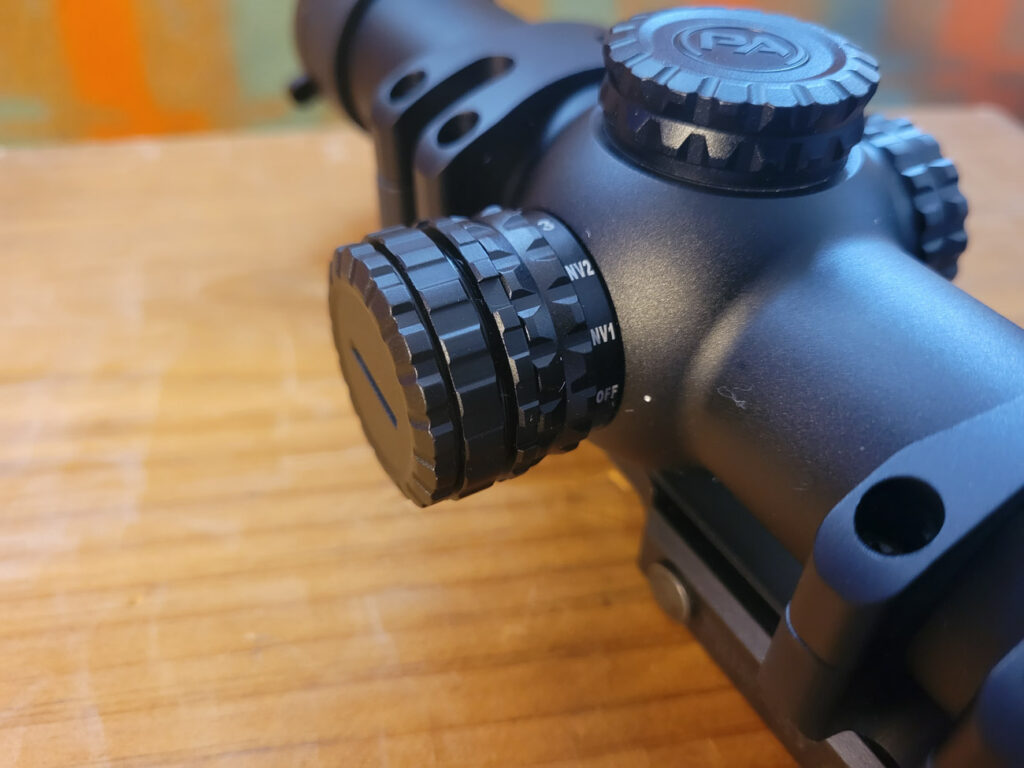
I plan to use my Auto-Live Cap as an insurance policy in case I forget to turn my illumination off. The convenience of the Auto Live Cap should be looked at as if it were a storage room lightbulb that people sometimes forget to shut off. For the sake of the power bill, you would turn the bulb off when you’re not using the room, but it would be nice for an auto shut-off in case someone forgets to turn the lights out. It’s for that reason that I would recommend purchasing the Auto Live Battery Cap with the proper optics if only to prevent yourself from leaving the illumination on. Batteries aren’t as cheap as they used to be, so you could find yourself saving enough on batteries to counter the cost of potential mistakes.
The ACSS Griffin M10S Reticle
A complex optic with a data-filled reticle is only as useful as the shooter’s knowledge. The reticle in this specific optic was Primary Arms’ ACSS Griffin M10S which features holds for things like moving targets, target ranging, and windholds. It also features a sharp chevron as a center point with an almost complete circle around the chevron. While I wasn’t a big fan of the thicker circle around the chevron, it was still an extremely useful reticle.

As it turns out, the circle around the chevron can be used for ranging targets that are 19 inches wide. This is supposed to represent the average width of a shoulder-to-shoulder torso. The first two of the longer hashmarks on the vertical post are also made to fit the width of a torso and can be used to range a target up to 500 meters. Not only can you use the width of a target for range estimate, but you can also use the longer lines on the horizontal posts to range through the target’s overall height. Primary Arms used 5’7” as the average height for those holds.

With plenty of usable features in the reticle, this should be a big reason to get a Primary Arms Optic. If you’re looking to update your skill and knowledge through the use of a data-filled reticle, then Primary Arms is the best option I’ve seen out of numerous manufacturers.
Pros
This optic made it simple to get sighted in and started with tests. The 10x magnification helped with seeing the 223-sized holes in the paper I was shooting. Here are the pros I found while testing and shooting the optic.
- Data-Packed reticle design
- Auto Live Cap saves battery cost
- Night Vision compatible illumination settings
- Low-Profile turret design
- Clear Glass
Night vision compatibility is something I’d like to see become more common with optics like this. As night vision becomes more and more common within the industry, I could see this becoming more common with optics. Similarly, I’d love to see the Auto Live Battery Cap become more widely available for more optics besides LPVOs. Many optics utilize illumination nowadays, so having the battery-saving feature is something I would use on all my scopes if I could.
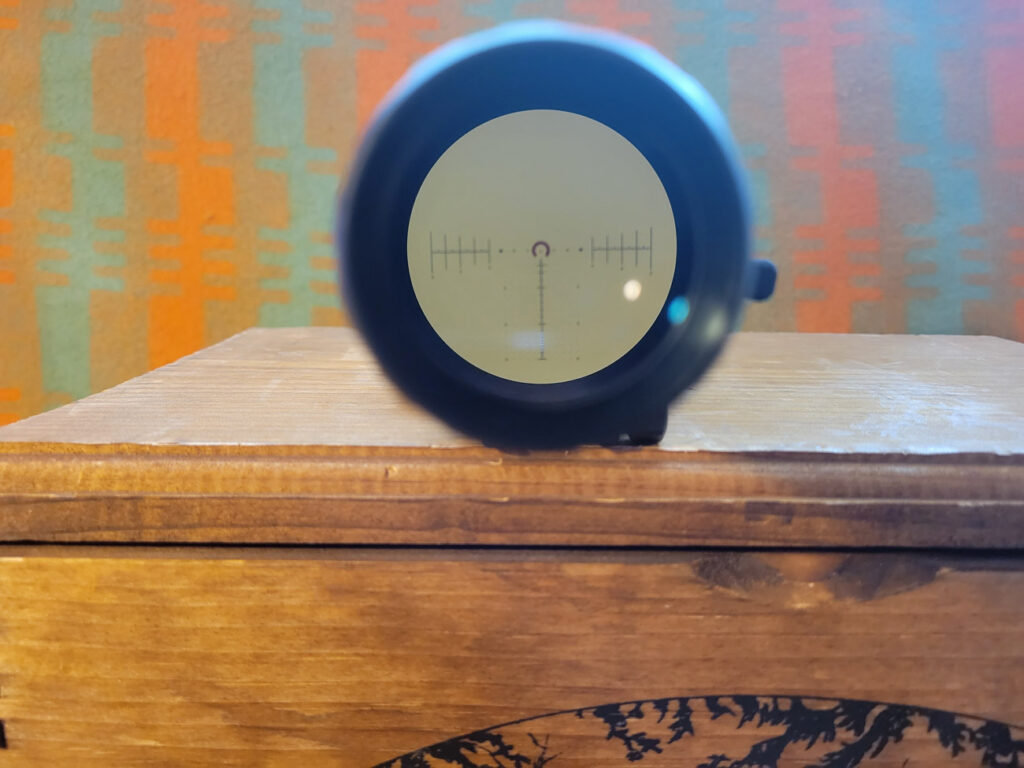
The reticles designed by Primary Arms are some of my favorite in the industry. Having grown as a shooter using a Mil-Dot design, I’m really happy with the reticles I get to utilize in PA Optics. These reticles take out the guessing game and a lot of the math that I wasn’t good at in the first place. The final pro I noticed was the low-profile design of the adjustment turrets. The low profile helped with the drop test, but it’s also nice when you don’t have to crank on turrets like some higher-magnification optics. Keeping those turrets out of your peripheral is the ideal design for this LPVO.
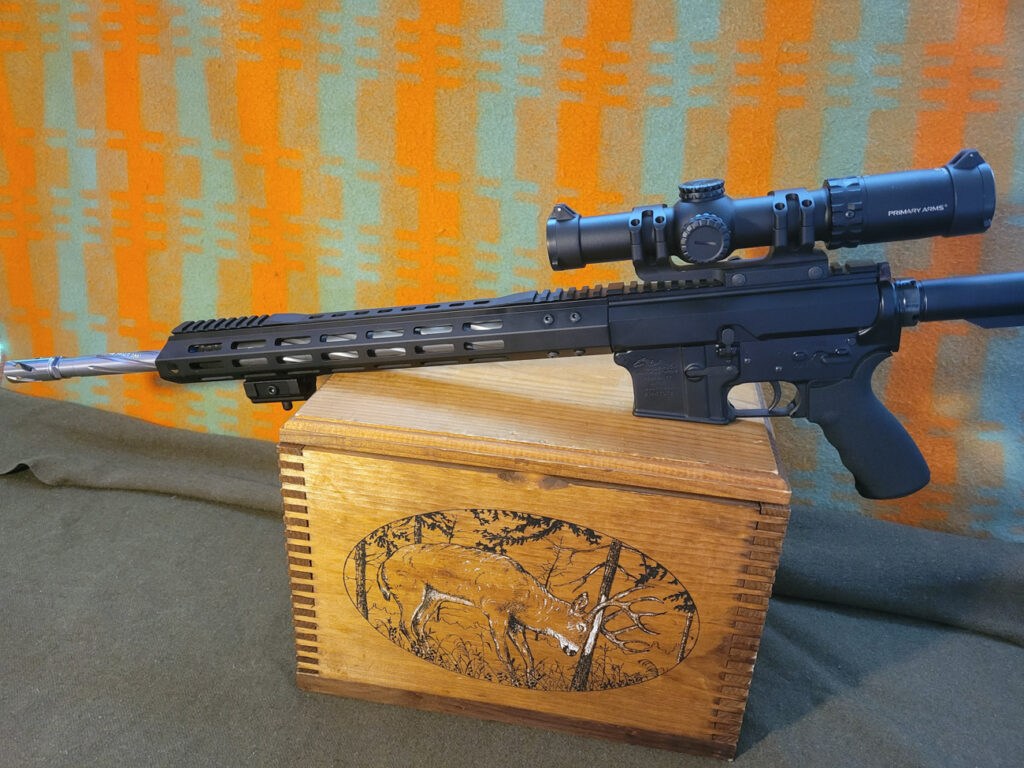
LPVOs with higher magnification ranges like this SLx are normally criticized for a lack of glass quality out to farther ranges. This issue is normally amplified since most of these LPVOs don’t have a focus/parallax knob. That being said, I looked through this glass out to 500 yards with no blurring, discoloration, or focus issue. While I was unable to test the parallax movement in the reticle at that distance, I was just satisfied that the image was clear at that distance.
Cons
As awesome as this optic performed in the tests I had, no scope gets through a review without cons. Some of these are simply results of any LPVO scope, but the other cons listed are more things to consider before purchasing the SLx 1-10 and the Auto Live Cap.
- Auto Live Cap could create bad habits
- Strange “adjustable” turret marking disks
- No parallax adjustment
In testing the Auto Live Battery Cap, I found myself leaving the illumination setting on for periods I wouldn’t normally leave it on. Granted, this was to test to see if the battery would last, but I could see some enthusiasts use the Cap as an excuse to simply leave their illumination on all the time. While this wouldn’t be a bad thing for a firearm that is only moved twice a year, I don’t think it’s the best application for a firearm that gets moved around a lot. If you do purchase the Auto Live Battery Cap, my suggestion would be to install it on the optic and forget it’s there. Use your illumination as you would normally, with the confidence that if you forget to shut it off, the Cap will save you a battery. That being said, I could see Auto Live creating some bad habits with some shooters.
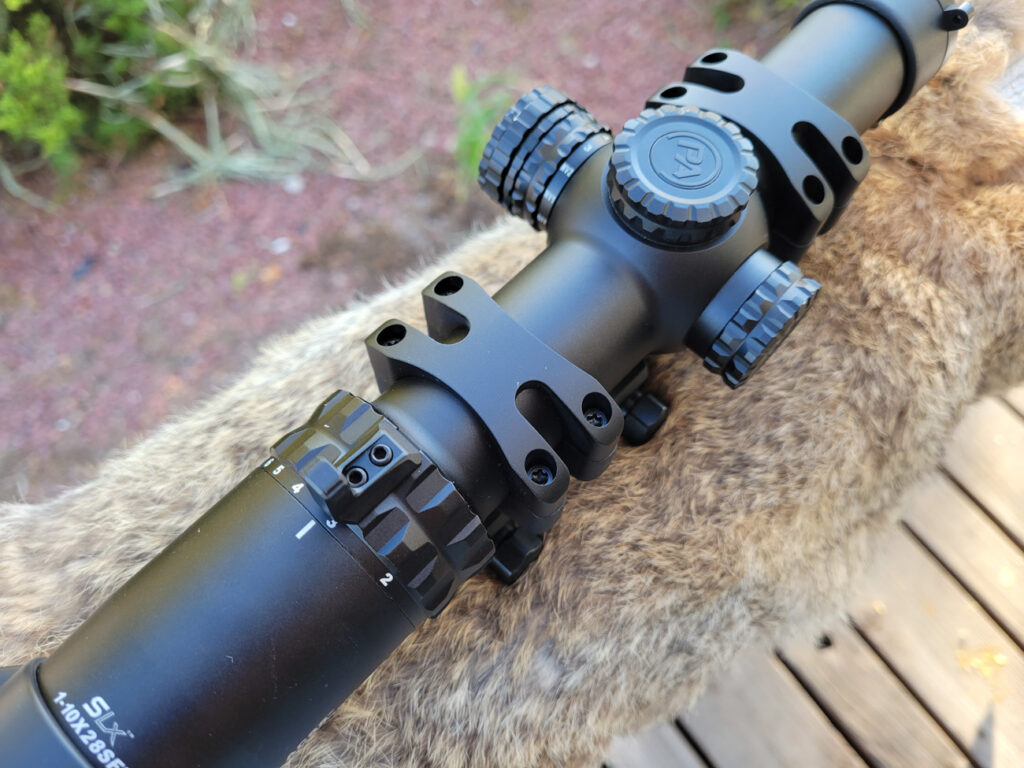
My least favorite thing about LPVOs is the lack of a parallax knob. Since I was testing the SLx at 100 yards, I could see the target move when moving my head behind the scope. This is what happens when your reticle and target are not in the same focus plane, and is the direct result of not having a parallax knob. I couldn’t even adjust for it with the eye-piece adjustment that is found on all scopes. Having the target and reticle on different focus planes at 100 yards could impact group size downrange. It’s because of that reason that I wouldn’t recommend the SLx 1-10 to a new shooter. To account for the lack of a parallax knob, a shooter has to have solid and repeatable fundamentals in the form of a consistent cheek weld and head position to shoot well with the SLx 1-10×28.
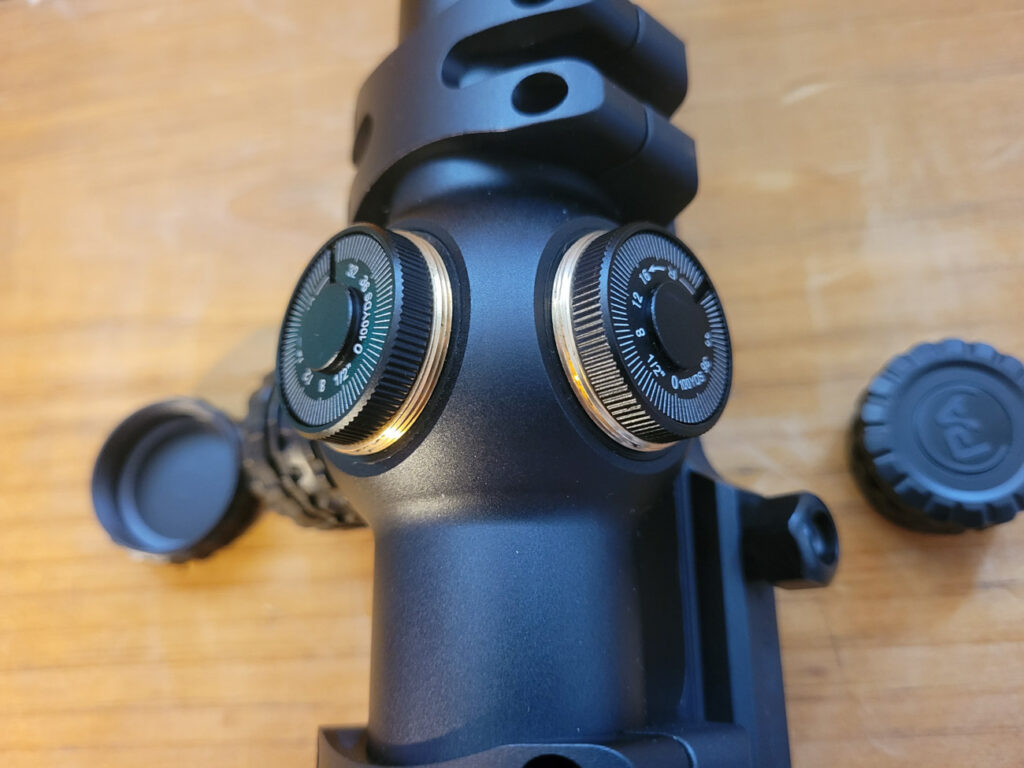
The last con I have is about the adjustment turrets under the turret caps. When you take off the turret caps of a scope, you can usually find a knurled knob that is used to adjust windage and elevation. There are also usually lines that will tell you how far you’re traveling with each click and allow you to keep up with the adjustment in your head. Under these turret caps, there was a disk with the normal lines for keeping track of your adjustment, but it was a movable disk that you could physically move inside the turret. I assume this is a quick setting to put a “0” on whatever your zero point is, but it was initially somewhat confusing as to the reason for this feature. While this is weird enough to end up on my cons list, I can easily see how some could put this into their pro list, so as mentioned above, make sure to keep in mind that these are just things to consider before purchasing the optic rather than just straight cons.
Cost Vs. Value
For the experienced shooter, there’s still value to be found in the Primary Arms SLx 1-10×28 LPVO. In my case, this would be a great starting point if I wanted to get into competition shooting. My fundamentals are consistent, so the lack of a parallax knob wouldn’t hold me back. The SLx 1-10×28 comes in at $450 with the Auto Live Caps coming in at an additional $50.

For a package total of $500, this scope provides a ton of value in what it gives the shooter. The comprehensive reticle design along with flawless tracking and durability make it a great option for an LPVO. I will say that there could be an experience barrier that could take some learning to get over, but the selling price is more than fair considering similar options out on the market.
Application
I’ve mentioned it prior in the review article, but 3-gun competition shooters would have an absolute hay day with this optic. Not only can you range and engage targets at a multitude of ranges, but you also get clear glass for a great price at the same time. Personally, this would be a great option to choose for coyote or hog hunting. The night vision compatibility would make this a fun scope to use on nighttime hog hunts, and the magnification is perfect for Missouri coyote hunting.
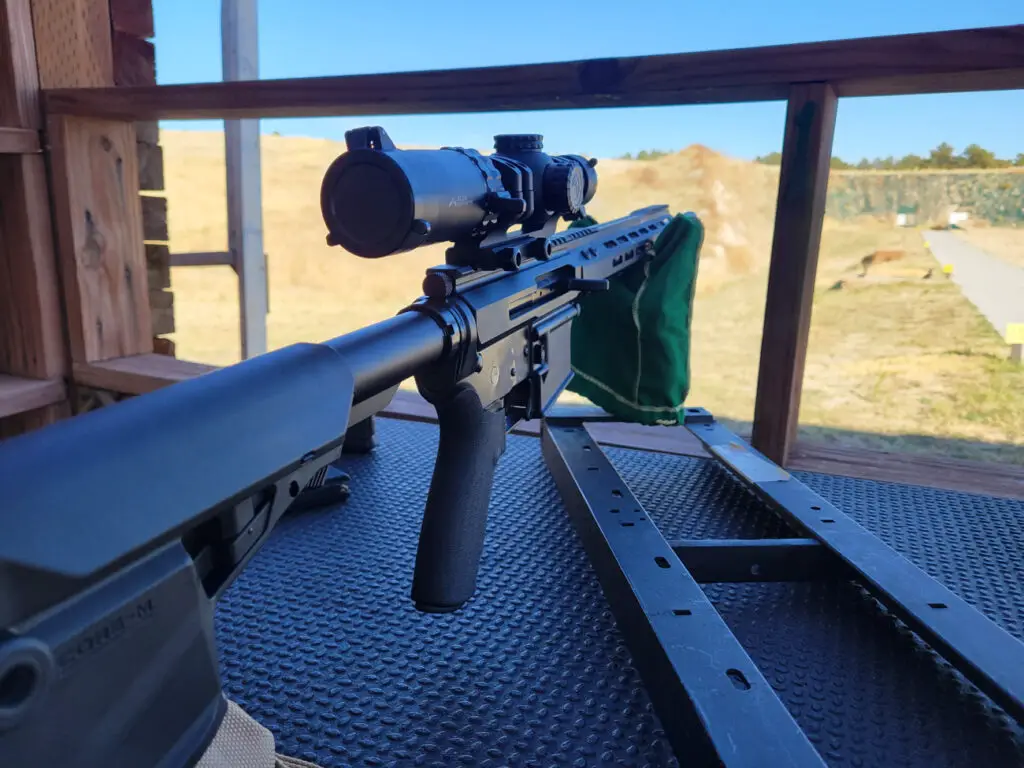
While hunting might not be the first application people think of, this would still be a great optic for a user to use in multiple applications at once. If I only had one AR, I could use this optic to hunt varmints and shoot steel whether it be competition or just plinking. As you read from the above paragraphs, I would reserve this optic for someone who’s experienced LPVOs in the past and can run one with the fundamental consistency to achieve the accuracy that can be achieved with the SLx.
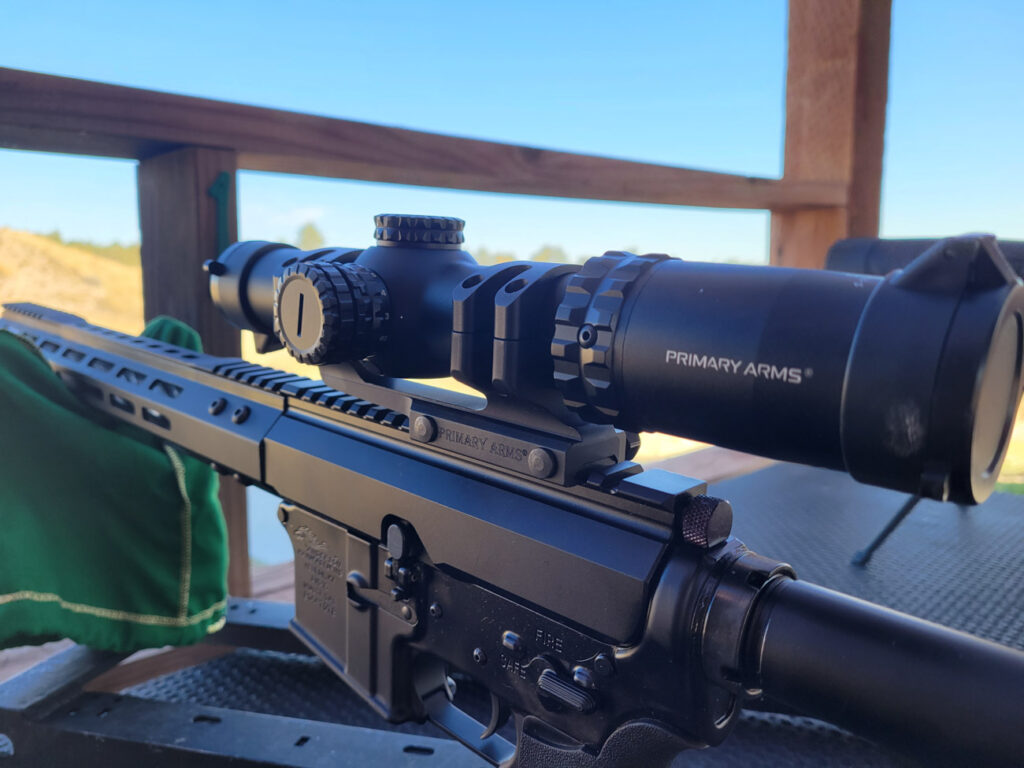
Whichever application you’re thinking of, it’s important to know that this is a steel shooting optic at heart. The holds and data points in the reticle are calibrated using steel target measurements and it’s the primary application in mind. Nothing is saying you can’t stick this on a hunting rig, but purchasing this scope means you’re allowed to burn down some competition stages at your next match. It would also be a fun optic to test load development and ballistic differences with all the data points that can be used for different ammo types.
Final Thoughts
The Primary Arms SLx line of scopes continues to set a performance standard amongst the other optics in my gun safe. There is a lot of flack that gets thrown towards LPVOs, but when used in the right application with the correct fundamentals, they become a utilitarian piece of gear that can be used in a variety of ways that can improve how you shoot at the range.
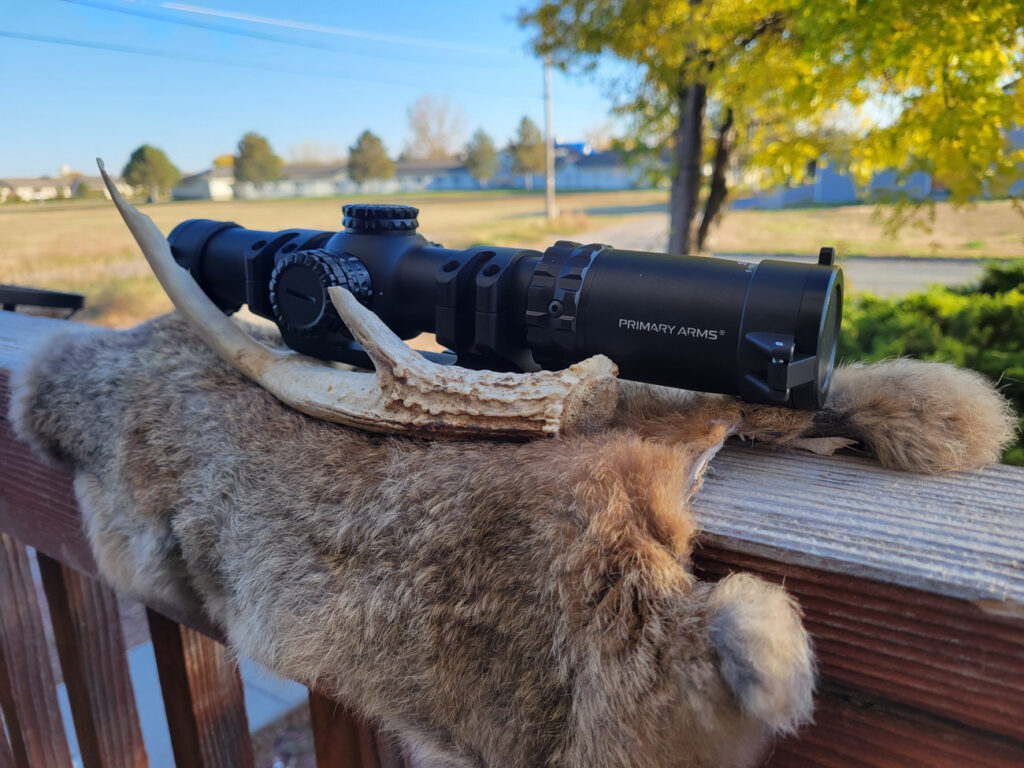
The Auto Live Battery Cap is also a great add-on for compatible scopes, and I’m excited to see if Primary Arms decides to include it on future scope models in the future. Being someone who forgets to turn off their illumination, I’m excited about all the money in dead batteries this cap is going to save me.
If you’re looking at an LPVO that provides great value for the price, look no further than the Primary Arms SLx series of LPVOs. Between the two I’ve tested, I’ve seen more performance-to-cost ratio than what is normally obtained with these types of scopes and would have no issues recommending it to enthusiasts of the right application. Take a look at Primary Arms’ website to see if the Auto Live Battery Cap fits an optic you already have, and if not, consider adding it to your next purchase of a compatible scope. It would be worth the money for the security it provides.
Check Price at:

Growing up, Buck was taught about firearm history and appraisal. Getting to know so many different firearm platforms eventually lead to his long-distance shooting exploration. While his main hunting past time is coyotes, he still find just as much satisfaction punching steel at distance. Every shot taken is with the purpose to become a better shooter.
